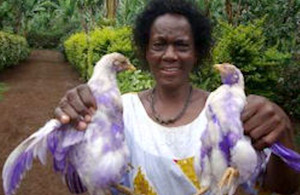DFID Research: Farmers in Tanzania paint chickens pink and purple to thwart hawks
Farmers in Tanzania, sick of losing their chickens to hungry hawks, have taken drastic, if creative action, thanks to an innovative programme funded by DFID and a little bit of pink dye

Chickens dyed purple to protect them from hawks. Picture: FIPS-Africa
How’s this for Easter chicks? Cunning farmers in Tanzania are outwitting hawks by dying their chickens pink and purple.
Farmers in Tanzania, sick of losing their chickens to hungry hawks, have taken drastic, if creative action, thanks to an innovative programme funded by UK aid and a little bit of pink dye.
It all started when farmer Wameiri Mpwanbao, who was losing two chickens a day to hawk attacks, was visited by an advisor from an organization called FIPS-Africa. Over a two-month period, she had lost 36 chickens. In a country like Tanzania, where one in three people live on less than £7 a month, this is a huge loss. Not only this, but her chickens were also dying from a deadly bird disease, called Newcastle disease.
The FIPS-Africa advisor told Wameiri to vaccinate her chickens and use a common antiseptic called Gentian Violet to dye them pink or purple.
“At first I thought it was a joke, but the chicks move about freely within the compound while the hawk is up in the trees, and he has never taken any since I tried it,” says Wameiri.
So far this year, FIPS-Africa’s advisors have helped over 3,700 farmers to increase the number of chickens they own through these simple but clever methods. More chickens mean poor families have more birds to sell, raising money to buy food, or pay school fees. A mature chicken is worth around £3 and dying and vaccination costs only 10p.
FIPS-Africa is supported by the Research Into Use programme, which is funded by UK aid from the government’s Department for International Development.